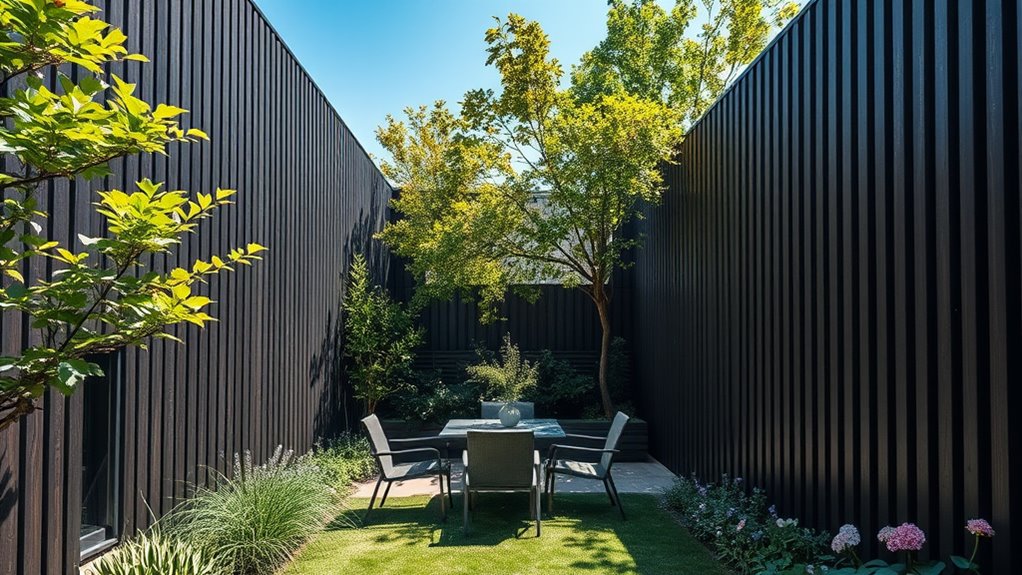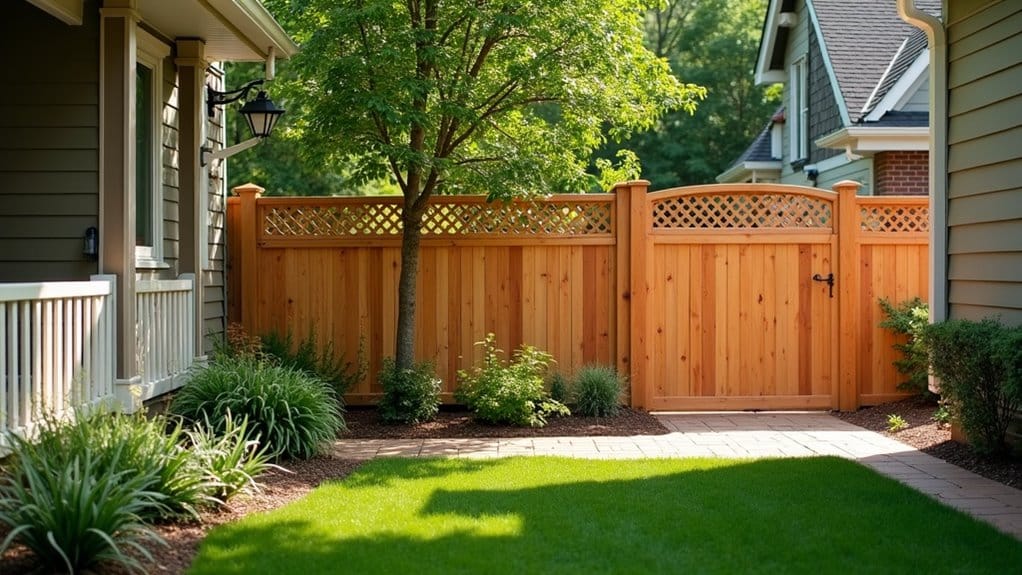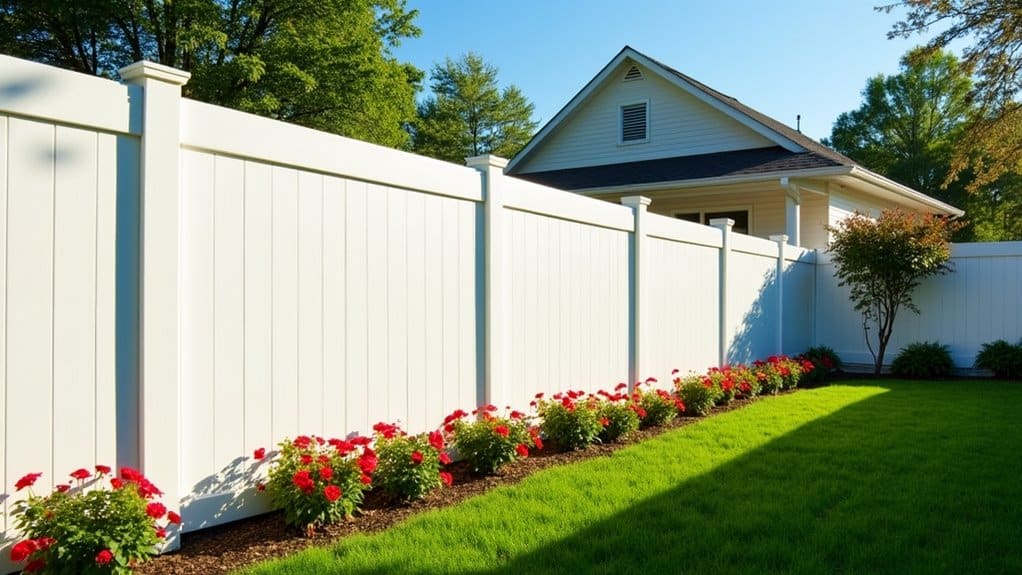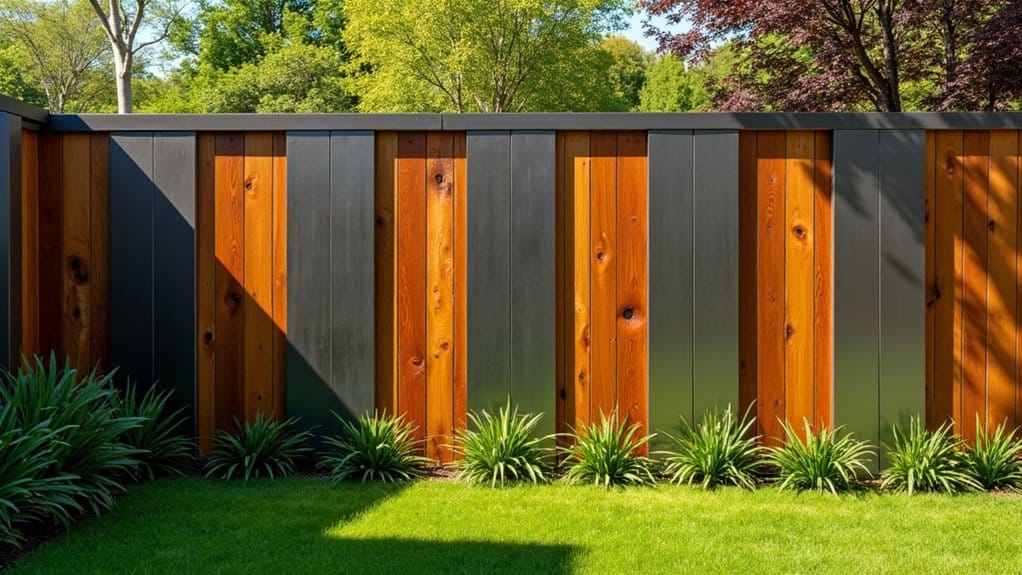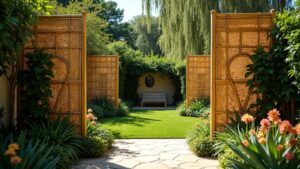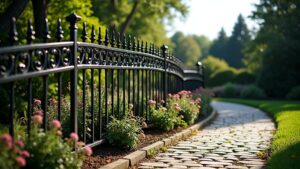Noise-reducing fencing is crucial for urban homes facing constant noise. It helps create a peaceful outdoor space. For the best sound reduction, materials like concrete or thick wood are recommended. Fences over 6 feet tall significantly block noise. Designs with few gaps or angled planks can disrupt sound waves effectively. Pairing your fence with plants can further enhance its noise-absorbing abilities. With various options available, the right choice can turn your yard into a quiet retreat.
Key Takeaways
- Noise-reducing fencing is a great way to block urban noise, helping you enjoy a peaceful outdoor space.
- Concrete fences are the best for soundproofing, while wood and vinyl offer good options with different looks.
- Fences taller than 8 feet do a better job at blocking sound waves.
- Always check local laws and HOA rules before installing noise-reducing fences to ensure compliance.
- Adding plants or trees around the fence can boost sound absorption and enhance its effectiveness.
Importance of Noise Reduction
Noise pollution in urban areas significantly impacts your well-being and health. It's not just an inconvenience; it can lead to serious health issues, such as cardiovascular diseases and sleep problems.
Raising awareness about these risks can help us advocate for effective noise reduction strategies that benefit everyone. Simple measures, like installing noise barriers or residential fencing, can significantly lower harmful noise levels, reducing stress and improving focus. You'll likely find yourself feeling more relaxed and productive. Additionally, reducing noise pollution can create a more enjoyable living environment, encouraging social interactions and strengthening community ties. Reducing noise levels can also enhance employee concentration and productivity by minimizing distractions. A well-constructed noise-reducing fence can further contribute to a peaceful atmosphere in your outdoor spaces.
As urban residents, it's important to support local initiatives and educate your neighbors to foster a quieter, more harmonious community.
Key Materials for Fencing
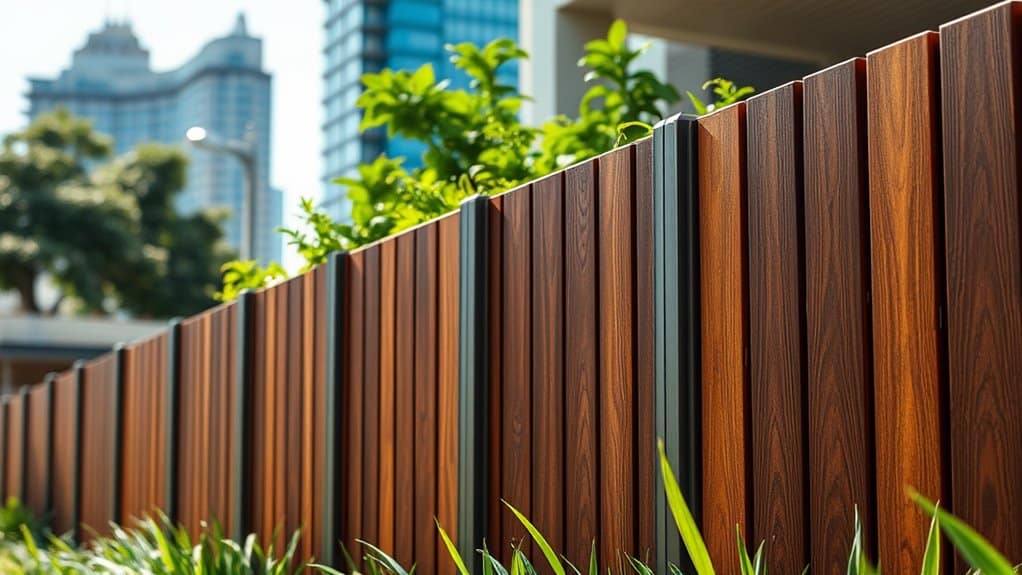
When selecting materials for noise-reducing fencing, consider effectiveness, aesthetics, and maintenance costs.
Wood, vinyl, concrete, and acoustic fences each come with their own pros and cons. For instance, while wood offers a natural look, it may require more upkeep. Additionally, vinyl fences are known for their durability and resistance to weather elements, making them a reliable choice for long-term use.
Vinyl is low-maintenance but can lack some sound absorption. Concrete fences provide excellent noise-blocking but can be visually unappealing.
Acoustic fences are designed specifically for noise reduction but can be pricier.
Material Effectiveness Overview
Choosing the right materials for noise-reducing fencing can significantly improve your urban home's peace. Here's a straightforward look at the most effective options:
| Fence Material | STC Rating | Noise Reduction Features |
|---|---|---|
| Concrete | 37 | Best for soundproofing due to high density. |
| Vinyl | 26 | Low maintenance, aesthetically pleasing, good noise absorption. |
| Wood (Cedar/Redwood) | 23 | Moderate sound reduction; thicker boards enhance performance. |
| Acoustic | N/A | Absorbs up to 80% of noise; customizable design. |
Concrete fences are the top choice for blocking sound effectively, though they may not be the most attractive option. Vinyl fences strike a balance between noise reduction and visual appeal. Wood fences, especially cedar and redwood, offer decent sound absorption but need more upkeep. Additionally, local climate can impact the durability and effectiveness of these materials in reducing noise. Acoustic fences are designed specifically for noise reduction and can be tailored to fit your style. Taller fences can also enhance the overall effectiveness of your noise-reducing solution, making it essential to consider height when selecting your materials. Make your selection based on what suits your needs best for a quieter environment.
Aesthetic Considerations
When choosing materials for noise reduction in your urban home, consider how they fit your aesthetic. Fence aesthetics are key to your decision. While concrete fences offer great soundproofing, their industrial look mightn't match your style.
Vinyl fences provide a variety of colors and designs, balancing visual appeal with decent noise reduction.
Wood fences, especially cedar or redwood, absorb sound well and add a warm, natural touch to your property. For an eco-friendly option, bamboo fences are a great choice, combining sound absorption with rustic charm. Additionally, medium-density fiberglass used in acoustic panels can significantly enhance sound absorption for added peace.
Acoustic panels can be added to existing fences or used as standalone features, giving you flexibility in design.
Think about custom designs that complement your architecture, enhancing both function and beauty. The height and placement of your fence are also important; taller options can block noise effectively while integrating into your landscape.
Aim for a balance between aesthetics and performance to create a peaceful outdoor space.
Cost and Maintenance
When choosing noise-reducing fencing for your urban home, it's crucial to consider both cost and maintenance.
Concrete fences excel in sound reduction, with an STC rating of 37, but they come with a higher price tag. If you're looking for a more affordable option, vinyl fences offer a decent STC rating of 26 without breaking the bank. Additionally, PVC fences are known for their long lifespan, making them a worthwhile investment in the long run.
Wood fences are usually the cheapest, but they require regular maintenance due to their lower STC rating of 23. Taller fences can also improve sound blocking capabilities significantly, making height an essential consideration.
In terms of upkeep, vinyl is the easiest choice, needing little maintenance. Concrete also requires minimal care, though it may not be the most visually appealing option.
Wood, however, demands consistent attention to keep it effective. If you choose medium-density fiberglass acoustic fences, you'll benefit from durability and long-lasting noise reduction with minimal upkeep.
Ultimately, the right choice balances cost, maintenance, and durability. Dense materials like stone or brick can be pricey but are highly effective for soundproofing, making them a sustainable solution for urban living.
Design Principles for Effectiveness
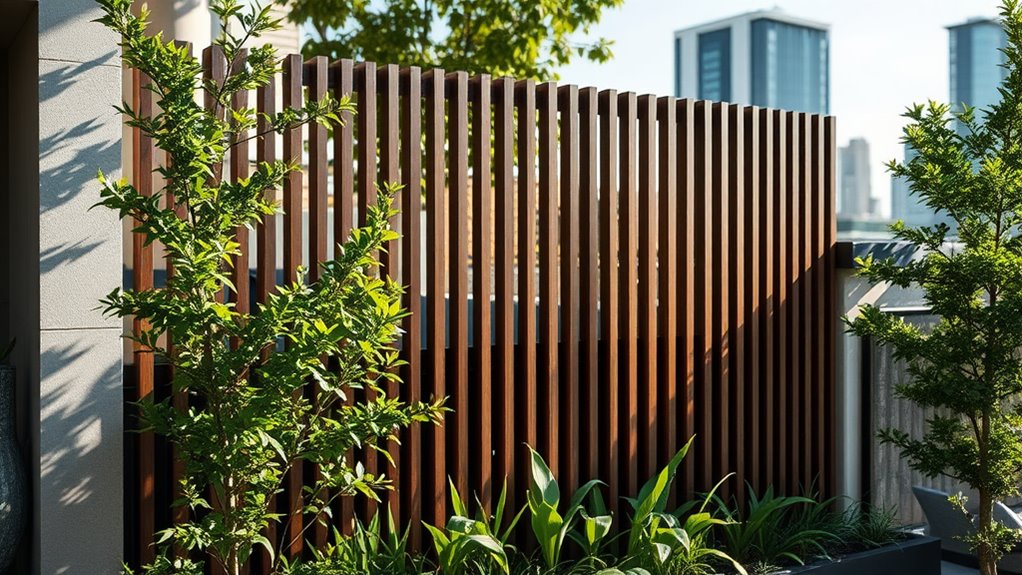
Effective design principles are crucial for creating noise-reducing fencing in urban settings. To optimize sound reduction, prioritize your choice of materials and construction methods. Denser materials, such as cedar or redwood, are excellent for blocking sound due to their weight. Additionally, consider adding sound-absorbing elements like vinyl or acoustic foam within the fence design for better results. A privacy fence can also enhance noise reduction by providing a solid barrier against sound waves.
Opt for solid panels with few gaps to effectively block noise, and use staggered or angled planks to further disrupt sound waves. For more options, think about incorporating acoustic barriers like mass-loaded vinyl or specialized acoustic panels into your design. Furthermore, ensure that your fence design includes proper height considerations, as taller fences can significantly enhance sound-blocking effectiveness.
Height Requirements for Fences

When considering noise-reducing fencing in urban areas, it's important to follow height requirements for optimal sound reduction.
Residential fences typically range from 3 to 8 feet tall. For backyards, a height of 6 feet is usually permitted, while front yard fences are limited to 4 feet for safety and visibility. Minimum fence height regulations set by Missouri law also dictate that fences must be at least 4 feet tall, which can help in noise reduction as well.
If effective noise reduction is your goal, aim for a fence height of at least 8 feet, as this can further decrease noise levels by about 0.5 dB for each foot above the line of sight.
Be aware that local regulations may impose specific height restrictions, especially for corner lots to ensure clear sightlines at intersections.
If you need a taller fence, you might be able to obtain a variance, but check with local authorities for the necessary permits.
Failure to comply with these regulations could result in legal issues and the removal of your fence.
Always prioritize following the rules to build an effective noise barrier.
Installation Techniques Overview
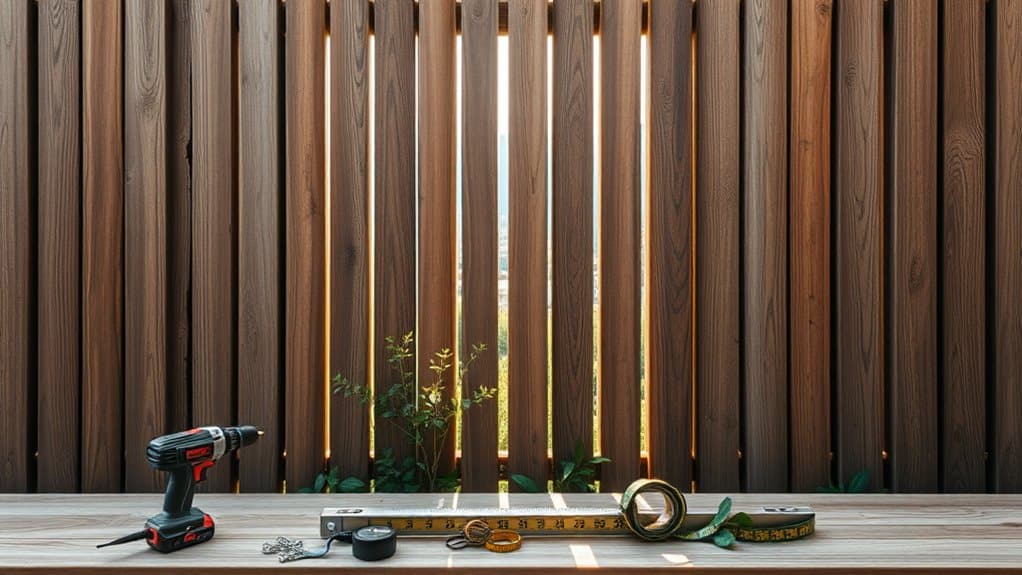
When installing noise-reducing fencing, height matters for effectiveness. Here are key techniques to tackle installation challenges and improve soundproofing:
| Technique | Description |
|---|---|
| Mass Loaded Vinyl (MLV) | Attach MLV tightly with staples or glue for complete coverage. |
| Acoustic Fence Panels | Secure panels directly to the fence using nails or screws. |
| Acoustic Fence Wrap (AFW) | Start at the bottom and overlap rows for better sound blocking. |
| Layering Materials | Use multiple layers to enhance noise reduction. |
| Vegetation Integration | Add thick plants to help absorb noise. |
Ensure there are no gaps during installation. For MLV, place screws every 12 inches on wooden fences. Position your fence close to the noise source for best results. Regular maintenance will help keep your fence effective over time, ensuring a quieter home. Incorporating heavier materials like cedar wood or brick can significantly enhance the soundproofing capabilities of your fence.
Common Applications in Urban Areas
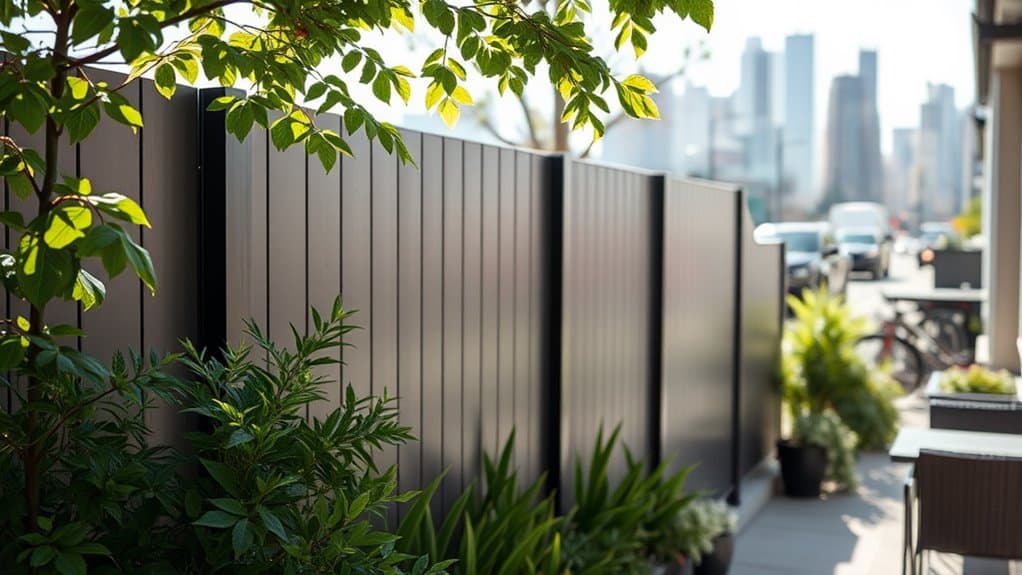
In urban areas, you often deal with issues like traffic noise and noisy neighbors. Noise-reducing fencing can help reduce these disturbances while also providing privacy, making your home feel more tranquil. An effective noise reduction fence system should focus on height and density to maximize sound-blocking capabilities.
Traffic Noise Mitigation
Mitigating traffic noise in urban areas is a growing challenge as cities expand and traffic increases. Effective noise barriers are essential in this fight. Materials like wood and vinyl can reduce noise levels by 7 to 10 decibels, making traffic sounds feel half as loud. Even a 6- to 8-foot fence made from sound-absorbing materials can significantly lower noise when placed strategically between your home and the road. In addition, urban soundscaping can improve your surroundings by adding green spaces and landscaping that absorb sound while enhancing beauty. Planting shrubs or trees can work as natural barriers alongside your fencing solutions. Effective road design is also crucial. Adjusting road layouts to increase distance from residential areas or managing traffic flow can reduce noise. For instance, restricting heavy vehicles on certain streets can cut noise by up to 10 dBA. By combining these strategies with your fencing, you can create a quieter, more peaceful living environment amid urban noise. Furthermore, noise levels are regulated by the EPA, which helps ensure that newly manufactured trucks do not exceed certain decibel limits, contributing to overall noise reduction efforts in urban settings.
Neighbor Disruption Reduction
To reduce noise disruption from neighbors in urban areas, consider effective fencing solutions that block sound. Use dense materials like wood, vinyl, or composites, which are good at absorbing noise.
Make sure the fence is solid and free of gaps to prevent sound from slipping through. Taller fences placed strategically can significantly minimize noise entering your yard, improving neighbor relations.
You can enhance the fence's look and noise reduction by adding soundproofing materials or acoustic panels. Planting thick shrubs alongside the fence adds another layer of sound absorption while improving aesthetics.
Regular maintenance is essential to ensure your fence remains effective.
If local regulations allow, features like water fountains can further mask unwanted noise. These strategies not only tackle noise issues but also create a visually appealing boundary, fostering goodwill with neighbors.
A peaceful urban retreat combines sound reduction with aesthetic enhancement.
Urban Privacy Enhancement
Urban homeowners often look for effective ways to boost their privacy without sacrificing aesthetics. One popular method is privacy landscaping, which involves combining fencing with lush hedges or trees. This creates a layered effect that enhances seclusion and adds natural beauty. Vertical gardens are another option; you can integrate living walls or climbing vines into your fencing for a unique look.
Here's a quick overview of privacy enhancement strategies:
| Strategy | Description | Benefits |
|---|---|---|
| Layered Privacy | Combine fencing with hedges/trees | More seclusion and beauty |
| Partial Privacy Walls | Use open sections or mesh panels | Allows airflow and light |
| Custom Design | Tailored fencing solutions | Meets specific needs and style |
To further enhance your privacy, consider sound barriers. Use thicker, solid materials that absorb noise and ensure a tight installation. This creates a peaceful outdoor space, improving your overall enjoyment. With these strategies, you can transform your urban yard into a private retreat that balances beauty and function.
Aesthetic Considerations for Homeowners
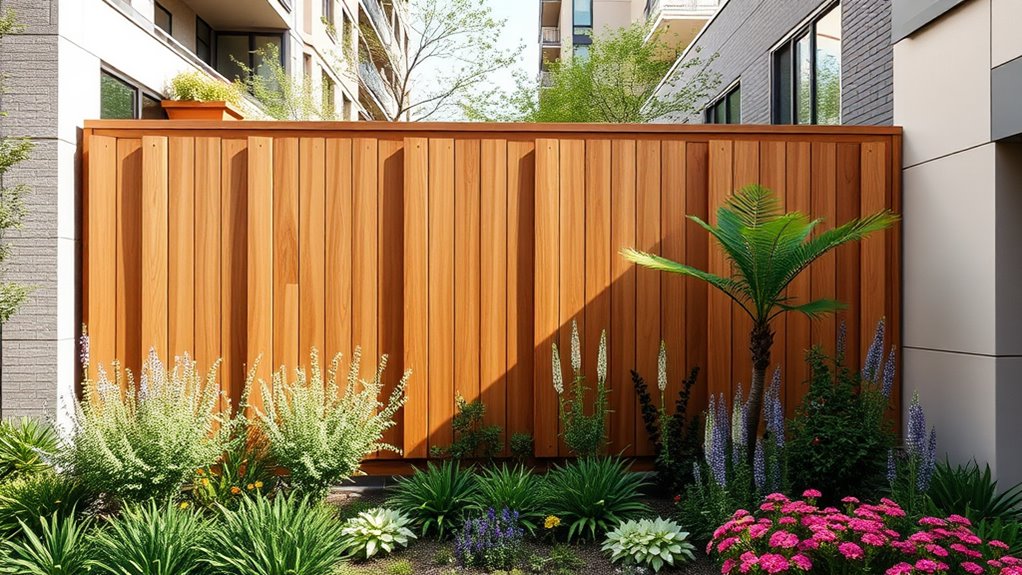
To create a peaceful living space, homeowners should consider noise-reducing fencing that also enhances outdoor aesthetics. Here are some key points to keep in mind:
- Material Choices: Think about using concrete, wood, or living walls for both style and sound absorption.
- Mixed Materials: Combining wood with acoustic foam can improve sound reduction while adding visual interest.
- Green Walls: Incorporating dense plants not only beautifies your yard but also helps absorb noise.
- Personalized Designs: Customize your fence with unique styles that reflect your taste and improve noise control.
Regulatory Compliance and Restrictions
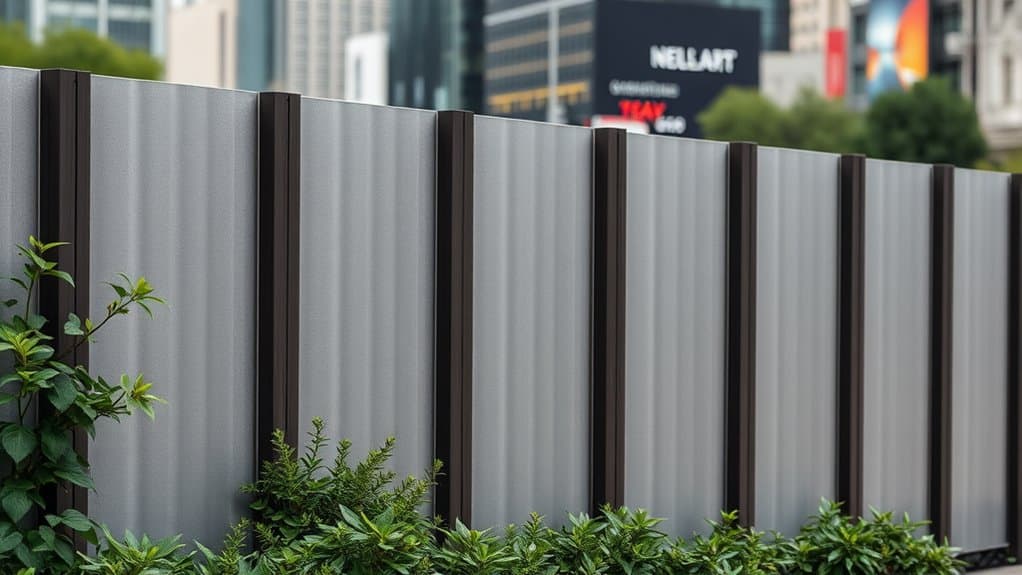
When considering noise-reducing fencing, understanding regulatory compliance is crucial. Start by checking local fence regulations, which usually limit residential fence heights to 6-8 feet. This can affect noise reduction, as a fence should ideally be at least 50% taller than the noise source for maximum effectiveness.
Also, placing the fence closer to the noise source will improve results.
If you live in a homeowners association (HOA), be sure to follow their guidelines, which may restrict materials and designs. Dense materials like wood and vinyl, or heavy options like brick, can help block sound but must still meet local codes and HOA rules.
Regular maintenance is key to keeping your noise-reducing fence effective. Ensure a solid, gap-free installation, and consider adding sound-absorbing materials to boost performance.
Benefits of Noise-Reducing Fences
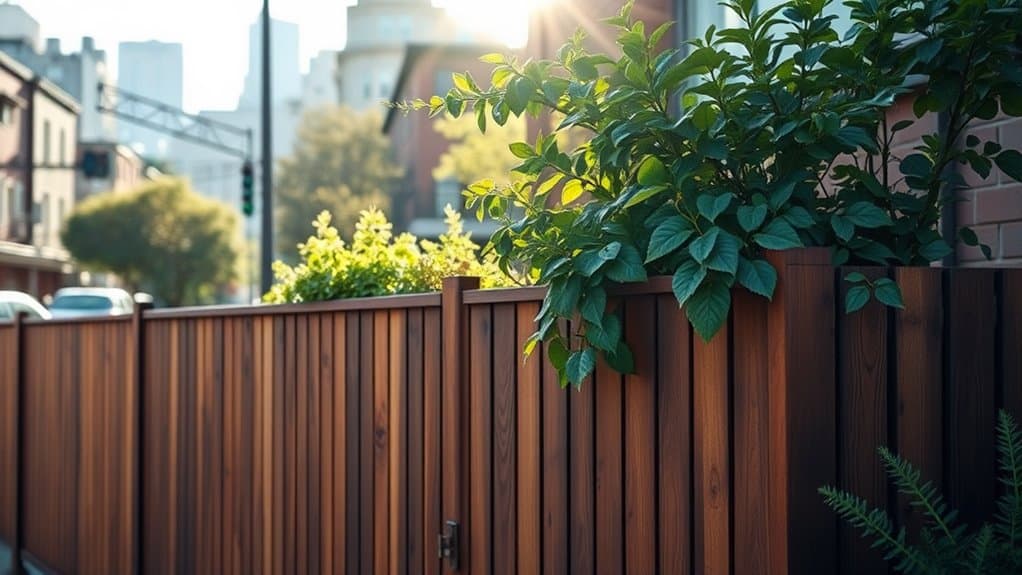
Installing noise-reducing fences provides significant benefits for homeowners wanting a quieter outdoor space.
These fences effectively block unwanted sounds, resulting in a more peaceful environment. Here are the main advantages:
- Sound Barrier: Solid fences keep external noise from disturbing your yard.
- Material Efficiency: Using thicker materials like heavy wood or mass-loaded vinyl greatly improves sound insulation.
- Aesthetic Appeal: Attractive fence designs enhance your yard's look while serving a practical purpose.
- Strategic Design: Taller fences with no gaps are more effective at reducing noise, especially near busy roads.
Limitations and Challenges

Noise-reducing fences come with several limitations that homeowners should consider before installation. One major issue is height restrictions imposed by urban regulations, which can hinder effective noise reduction. Additionally, design constraints may limit material choices; for example, thinner materials like plastic do not block low-frequency sounds well.
Here's a brief look at the challenges:
| Challenge | Impact on Soundproofing | Considerations |
|---|---|---|
| Height Limitations | Reduced noise reduction | Comply with local rules |
| Material Durability | Increased maintenance | Opt for dense materials |
| Installation Complexity | Requires skilled labor | Consider hiring a pro |
The surrounding landscape and the direction of noise sources can also complicate soundproofing. Gaps in the fence can significantly diminish effectiveness, so sealing is crucial. Weighing these factors is important. Balancing aesthetics with functionality can be tough in urban settings, but understanding these challenges helps you make better decisions for your home.
Additional Soundproofing Options
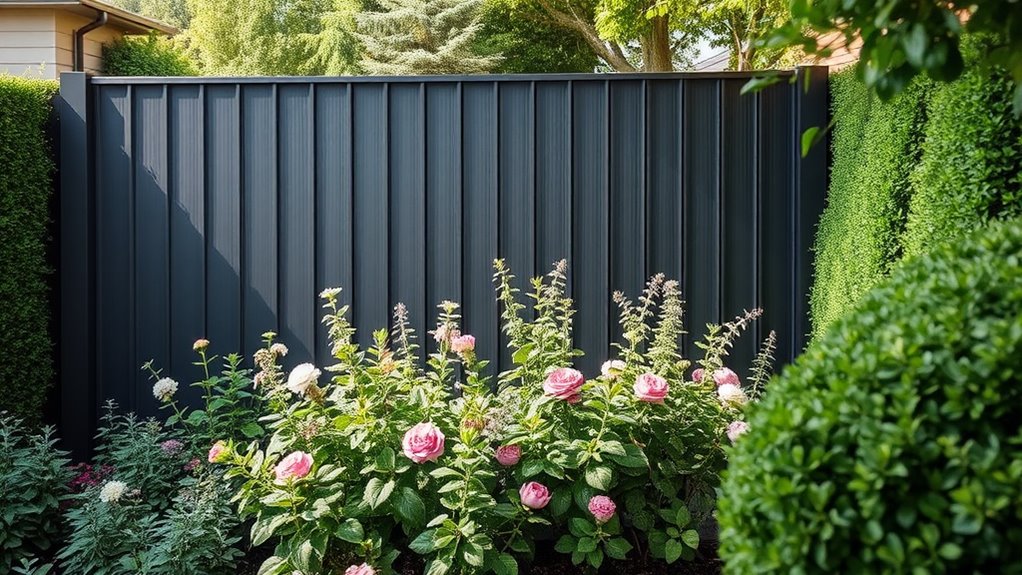
To improve your home's soundproofing, consider double-glazed windows. They significantly cut down outside noise and boost energy efficiency.
You can also add insulation like Quiet Batt or Mass Loaded Vinyl for a quieter space.
Additionally, using landscaping—like planting trees and shrubs—can naturally block urban noise, creating a more peaceful environment.
Double-Glazed Windows Benefits
For urban homeowners looking for peace amidst the noise, double-glazed windows are an effective solution.
These windows can reduce external noise by 20-65%, depending on factors like glass thickness and frame quality.
Here's why they're essential for city living:
- Noise Reduction: The air or gas layer between the panes absorbs sound vibrations, significantly lowering noise levels.
- Energy Efficiency: Double glazing minimizes heat loss, keeping your home warm and energy-efficient.
- Security: The two panes of glass offer added protection against break-ins.
- Visual Appeal: Quality double-glazed windows enhance your home's aesthetic while providing soundproofing.
Proper installation is key to maximizing noise reduction, with high-performance options achieving sound reductions of up to 35 dB.
Insulation Enhancements
Improving insulation with soundproofing materials is crucial for urban homeowners wanting a quieter home. To effectively absorb sound, consider using Mass Loaded Vinyl (MLV) for its density, which blocks sound waves, and acoustic foam to reduce echoes.
Fiberglass and cellulose insulation also work well for sound absorption in addition to thermal resistance. Polyiso foam is another great option known for its soundproofing benefits.
To enhance your fence's effectiveness, seal any gaps to create an airtight barrier against sound. Adding dense materials like wood or brick increases the mass of your fence, which helps block noise. Raising the height of your fence can also improve privacy and sound reduction.
Lastly, think about specialized acoustic fence panels or wraps for significant noise reduction, creating a more peaceful outdoor space. By choosing the right materials and methods, you can turn your urban home into a serene retreat.
Effective Landscaping Techniques
Effective landscaping can significantly improve soundproofing in urban areas. Here are some straightforward strategies to create a quieter space:
- Dense Vegetation: Plant thick shrubs and trees to absorb noise.
- Layered Planting: Use staggered rows of plants at different heights for better sound absorption.
- Year-Round Coverage: Choose evergreens and dense shrubs to maintain a sound barrier throughout the year.
- Water Features: Add water elements like fountains to create white noise that covers unwanted sounds.
These techniques not only enhance your outdoor aesthetics but also contribute to a more peaceful living environment.
Combining plants with solid barriers like fences will further improve soundproofing.
Landscaping for Enhanced Noise Control
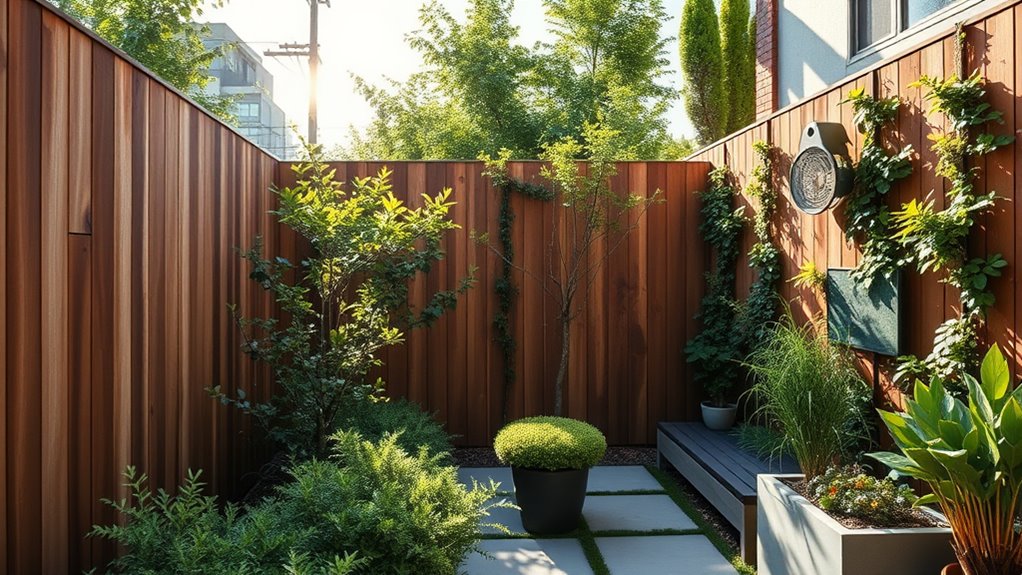
In urban areas, landscaping isn't just about looks; it's a key strategy for reducing noise. Choosing a variety of plants can significantly improve sound absorption. For instance, dense evergreens like spruce and fir, alongside shrubs such as boxwood and holly, create effective noise barriers.
To enhance noise control, arrange plants in staggered rows of different heights. This layered approach boosts coverage and sound reduction. Adding berms or raised beds can further block sound waves.
Also, consider using solid fences or tall hedges as buffer zones to obstruct noise travel. Water features can help mask noise by providing a natural white noise effect.
Regular maintenance of your plants and barriers is crucial to keep their noise-reducing benefits. By using diverse plants and smart landscaping techniques, you can create a quieter urban environment while improving your outdoor space.
Frequently Asked Questions
How Long Do Noise-Reducing Fences Typically Last?
Noise-reducing fences generally last about 20 to 25 years. Their lifespan depends on factors like sound absorption quality, maintenance, and how well they're installed. Choosing strong materials helps ensure they remain effective against noise while standing up to weather conditions.
Can I Paint My Noise-Reducing Fence?
Yes, you can paint your noise-reducing fence! Use latex or acrylic paint for the best results. Make sure the paint is compatible with your fence material to ensure it lasts. Choose colors that not only look good but also fit your outdoor space.
What Is the Estimated Cost of Noise-Reducing Fences?
When choosing a noise-reducing fence, think of it as a sound barrier. Prices typically range from $1,770 to $4,560, depending on the materials you select and how complicated the installation is.
Do Noise-Reducing Fences Require Permits for Installation?
Yes, installing noise-reducing fences typically requires permits. It's important to check your local regulations to ensure you comply with height limits and material rules. This helps you avoid legal issues and ensures a smooth installation process. For example, some areas may only allow fences up to a certain height, so be sure to do your research before starting.
How Can I Maintain My Noise-Reducing Fence?
To keep your noise-reducing fence in good shape, check for gaps and clean it regularly. Use waterproof sealants to protect the material, and fix any damage right away. This will help maintain its durability and effectiveness in blocking sound.
Conclusion
In busy urban areas, noise-reducing fencing serves as an effective sound barrier, turning disruptive noise into a peaceful environment. Choosing the right materials and design can help you create a quiet retreat that's also eco-friendly. It's more than just a fence; it's about creating a calm space. Combine your fence with smart landscaping to enhance tranquility, allowing you to enjoy a quieter home.

